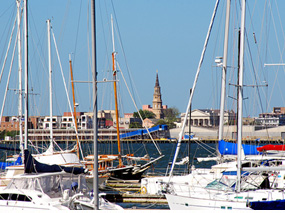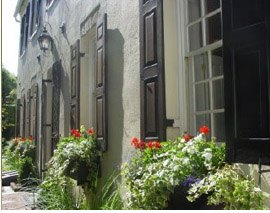Dolphins and
porpoises, for example, are often seen anywhere from tidal creeks to
open ocean, fins breaking the surface in groups as they search for
fish, or jumping in speedy solos ahead of bow waves pushed by
passing boats.
From a distance,
it's hard to tell a dolphin from a porpoise - both are air-breathing
mammals with long, gray bodies, round heads, fins, flippers and
flukes that project sound waves underwater to get their bearings.
Some dolphins have a protruding beak, and thus the name
"bottlenose", but the only consistent difference is that porpoises
have bigger teeth.
One behavior
common to both is called "tailing" - seemingly standing on their
heads in shallow water, thrashing tail flukes while digging in muddy
bottoms for fish. Another is known as "stranding" - swimming at
great speed out of the water on to dry land, pushing a wall of water
and fish in front, before eating the fish and wiggling back into the
surf.
Another frequent
visitor is the manatee - a bigger, slow-moving mammal that resembles
a giant baked potato with flippers. Also known as sea cows, manatees
come in from offshore to lap up fresh water and graze on aquatic
plants that grow easily in Charleston's warm climate, and have often
been hand-fed along area docks by folks with a garden hose and a
head of lettuce.
Just
offshore, Charleston is surrounded by an abundance of reefs that
brim with bright coral and creatures. Most are man-made, the result
of old
shipwrecks, but in recent years, a state program has intentionally
sunk everything from concrete bridges to obsolete U.S. Army tanks to
extend the reef environment. 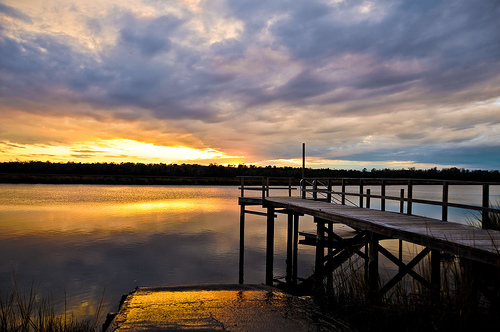
Sinking
environmentally-safe steel and concrete in select offshore areas
around Charleston has turned 20 square miles of lifeless sand into
what's known as "live bottom", where sponges, corals and other
inverterbrates attach to hard surfaces and begin the food-chain that
attracts swarms of fish.
At depths ranging
from 20 to 110 feet, visibility is much clearer, and reef divers
find octopus, barracuda, anemones and sailfish among the diverse
underwater population. Anywhere there's real activity below the
surface, there's reel activity above it, and offshore reef-fishing
near Charleston is very popular throughout the year. Changing water
temperatures attract an ever-revolving menu of cobia, amberjack,
sheepshead, tuna, sea trout, grouper, mackerel, spadefish, pompano
and shark.
Back inshore, some
of the catching techniques haven't changed much since ancient times,
and along extensive estuaries to the north an south of the city,
flooded mud flats and marsh grasses spawn shrimp, mollusks, crabs
and fish that are caught by nets, hooks, spears, hands, shovels,
hammers, tongs, and traps, while some sea creatures have been known
to jump in the boat by themselves.
Flyfishing for red
drum from flat boats pushed into shallow bays with poles is
tremendously popular with locals, as is recreational shrimp-baiting,
in which newly-mature white shrimp emerging from marshes in the Fall
are caught in cast nets.
People in the
Charleston area still "scratch" for clams in mud at low tide,
looking for a small opening, or "key hole", that indicates where the
clam has burrowed before digging after it. The stone crab's powerful
claw is a delicacy that takes some nerve to retrieve. They burrow in
holes beneath oyster beds, where catching requires reaching in
with bare hand to scoop the critter out without losing a finger or
two of your own.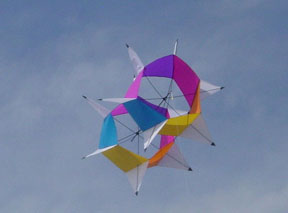 Because the creature's claws will regenerate, the accepted practice
is to take one off and throw the crab back.
Because the creature's claws will regenerate, the accepted practice
is to take one off and throw the crab back.
Oyster roasts are
a long-standing Charleston tradition that usually feature clusters
gathered from mud banks at low tide, where harvesters often plod in
with hammers to dislodge masses of shells.
Another old
favorite is "gigging" or "graining" for flounder at night with
bright lights and long spears in shallow water. The lights attract
the fish, which although well-camouflaged by changing pigments in
their scales, are spotted by a well-trained eye, impaled and hauled
in.
The most
memorable and visual marine harvesting method around Charleston is
that of the shrimp trawler, and the local fleet high-bowed,
flat-bottomed boats topped with wing-like outriggers has been a
fixture along the docks of
Shem Creek since the 1920's.
The typical
trawler day begins about 4 a.m., as diesels are fired up and boats
move off into the darkness while crews gobble fried eggs, grits and
bacon in the cramped galleys. By daybreak, the trawlers are a few
miles offshore, swinging outriggers to each side and lowering huge
nets behind them for a trawl or drag.
Keeping nets
spread is critical, and is done horizontally by lowering flat,
wooden "doors" inside the outer edges on either side, as the
buffeting force of water holding nets open. Vertically, a bouyant
"float line" keeps the upper side of the net on the surface, while a
weighted "foot rope" drags the lower end across the bottom, kicking
marine life up into the net.
A typical trawl
must be pulled in a straight line at about 3-4 knots, just fast
enough to trap sea life, but slow enough to hold the net's shape.
Because there's no way of seeing what's going on below the surface,
a smaller "try net" is dragged and pulled in from time to time to
make sure shrimp are there.
Depending on the
trawler captain's instinct as to when the catch is full, nets are
winched in and dumped on deck. A good trawl will yield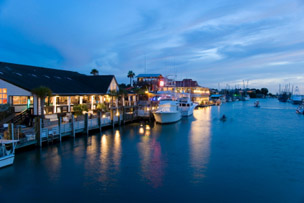 hundreds of
pounds of shrimp and "by-catch" - fish and crabs too large to escape
through the mesh of the net.
hundreds of
pounds of shrimp and "by-catch" - fish and crabs too large to escape
through the mesh of the net.
Everything
marketable is packed in ice, the rest is swept over the side, and
the trawl begins all over again. It's a familiar sight from Charleston
beaches as the trawlers rock slowly by, joined by hordes of sea
gulls overhead and pods of dolphins and porpoises behind, all
looking for a free meal.
In fact, when a
shrimp trawler returns to Shem Creek, the success of the day can be
measured as easily by the weight of shrimp on board as by the wake
of creatures that follow right up to the docks.
Getting on the
water is a cherished Charleston treat as well, and it's available
under power, under sail or by paddle. Harbor tours, dinner cruises
and tours to historic Fort Sumter are featured on SpiritLine
Cruises, whose flagship, The Spirit of Carolina, seats up to
400 passengers on three viewing decks that include dining areas and
bar. Private charters are also available, and for tour times and
information, call 843-881-7337 or 1-800-789-3678. For a taste of the
tall-masted sailing vessel, The Schooner Pride offers tours
and charters aboard a classic 84-foot top-sail rigger. Harbor tours
and romantic sunset cruises offer passengers a chance to lap up the
brisk sea breezes and take in the marvelous sights of historic
Charleston Harbor and passing seagulls and dolphins. For
reservations and information call 1-800-979-3370.
For those who
would prefer to explore the many charming creeks and waterways in a
more intimate fashion, paddling adventures by canoe and kayak are
offered in guided tours as well as rentals. Nature Adventures
Outfitters features guided tours of wetland areas by experienced
naturalists, taking in the unique diversity of barrier island
habitat, blackwater swamps and salt marsh estuary that surrounds
Charleston. For information, call 1-800-673-0679 or e-mail
natureadventuresoutfitters@worldnet.attnet.
